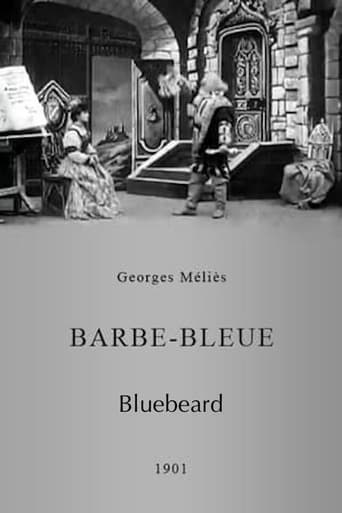Hitchcoc
In this Melies film, he stays pretty true to the legend. A man who has managed a great fortune, talks another man into giving him his daughter in marriage. She resists, but the financial gains clinch the deal. They have a really interesting wedding feast with huge foodstuffs. Now he takes her into the courtyard and tells her the whole castle is hers, except for the one room. He gives her a key but forbids her to use it. Of course, she does and realizes what her fate is going to be--there are seven women hanging in the room (pretty harsh stuff). Anyway, it is now up to her to be enterprising and survived. The conclusion is a bit scattered, but it's fun anyway.
alexx668
Arguably, the first bona-fide horror film ever made. The scene where the wife goes to the cellar and finds the hanged bodies of the previous wives is genuinely chilling, and the eerie dream scene is very well done.There is really no exaggerating of Georges Méliès' importance in the history of cinema, inventor of special effects, an early expressionist before expressionism even officially existed, a wizard creator of magical worlds, a canny surrealist a full two decades before surrealism was even born, a trickster and relentless comedian that knows no bounds: more than an innovator, Méliès is a genius.
Cineanalyst
Film historians, like Richard Abel, sometimes split most of the films of Georges Méliès into two categories: the trick films, which are the shorter, generally one-scene films that are entirely about the attraction of the special effects, and the féeries, or fairy films, which are longer, narrative films, fantastic in their subjects, and with multiple tableaux. "Bluebeard" is obviously one of the féeries. Characteristic of the genre, it even has a fairy that manipulates the characters, including their dreams, and the plot of the film. Later films that are often considered fairy films (or fantasy films), such as "Le Voyage dans la lune" (1902), don't involve a fairy to such an extent. Méliès began making these longer narrative films by 1899, beginning with "Cinderella" (Cendrillon). As with "Cinderella" and about every story film of his, Méliès uses the tableaux vivant style, dissolves to transition between the single-shot scenes and studio sets for a theatrical style of narrative. Exhibitors also tended to rely upon the extra-filmic lecturer (which was common then even for non-narrative films, but they became especially useful in aiding audiences in following complex narratives such as this one). Méliès would even provide exhibitors with the narration for the lecturers--including story details that would otherwise be uncertain or unknown. In addition, as with "Cinderella", "Bluebeard" is based on a story by Charles Perrault. Other filmmakers would eventually create more cinematic story films, but at first, they would imitate Méliès's féeries, but with their own regional influences, such as in Robert W. Paul's "The Magic Sword" (1901) and Edwin S. Porter's "Jack and the Beanstalk" (1902). Pathé was also quick to imitate all things Méliès and to try to take over his market.On its own, "Bluebeard", at ten scenes, is an elaborate production for its time when compared to the short films of often only one shot that continued to coexist with the development of these story films. Méliès would even continue to make both kinds of films. Additionally, although stagy, the set designs by Méliès were the best in filmdom at the time. The film's story is also very good for a Méliès production, including two rather macabre scenes. I especially appreciate the demon, or devil, and fairy characters. They both watch over Bluebeard's wife; the demon, or devil, tempts her into danger, while the fairy protects her against harm. In the dream scene, they both control the wife's superimposed dream images above her. The fairy's control of the narrative reappears in the aforementioned "The Magic Sword" and "Jack and the Beanstalk", as well as in other Méliès films such as "Kingdom of the Fairies" (1903)--reaffirming its centrality to the fairy film.
karl-68
this movie has great backgrounds from the castle,the greatest moment is a real horror moment when the woman goes into the forbidden room and finds the hanged 7 ladies all former wives of bluebeard,another great moment is when the woman sleeps and dreams when the ghosts of the 7 dead wives and the dancing keys appears.


